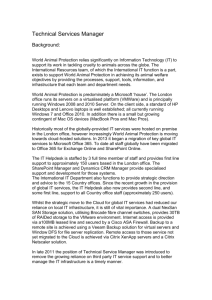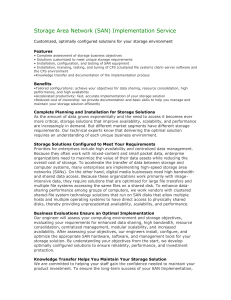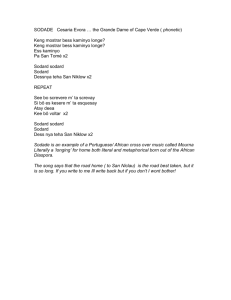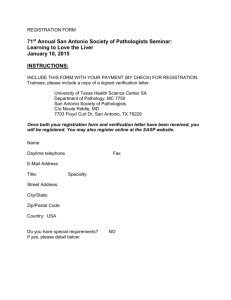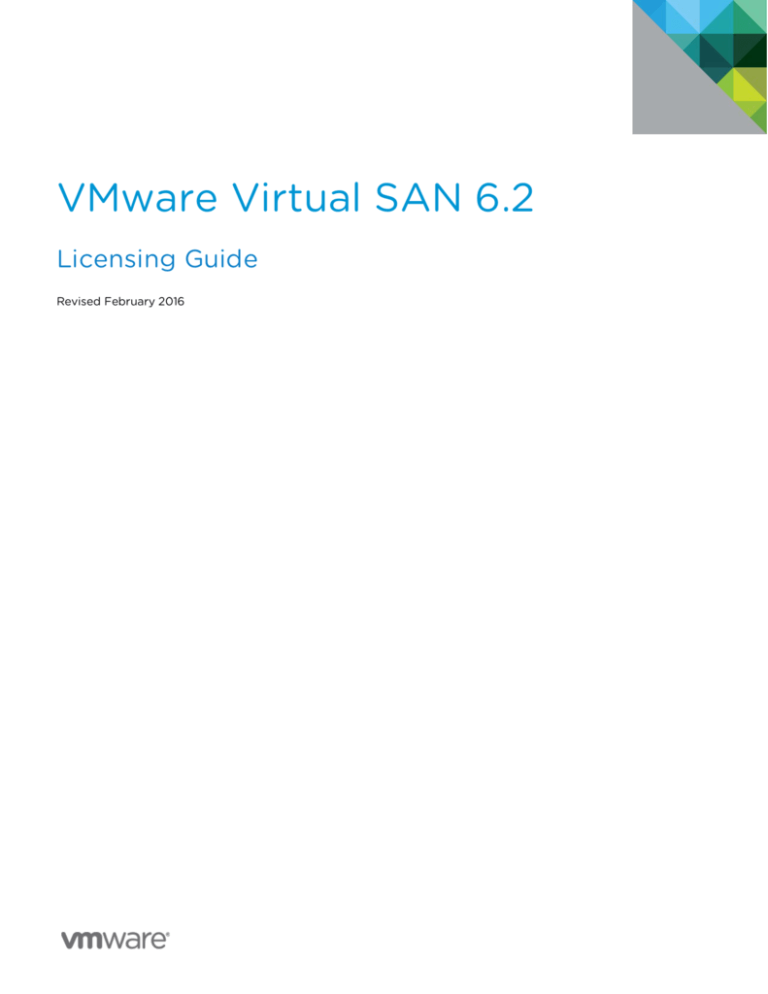
VMware Virtual SAN 6.2
Licensing Guide
Revised February 2016
Contents
Introduction ................................................................................................................................ 3
Licensing Editions....................................................................................................................... 4
Examples ................................................................................................................................... 7
Summary .................................................................................................................................... 9
Introduction
VMware, the market leader in powering Hyper-Converged Infrastructure (HCI), enables the
lowest cost and highest performance next-generation HCI solutions through proven VMware
Hyper-Converged Software. The natively integrated software combines radically simple VMware
Virtual SAN™ storage, the marketing-leading VMware vSphere® hypervisor, and the VMware
vCenter Server™ unified management solution with the broadest and deepest set of HCI
deployment choice.
Virtual SAN 6.2 delivers the industry’s best storage value with radically simple management, high
performance, low cost and a future-proof roadmap supporting any app, any scale. Virtual SAN
pools server-attached magnetic disks and solid-state flash devices to create a distributed shared
datastore that abstracts the storage hardware and provides a hyperconverged storage
optimized for virtual machines. It is transformational technology that delivers unique value to
VMware customers:
•
Radically Simple – Deploy easily through the vSphere web client and automate
management using storage policies
•
Elastic Scalability – Scale out or up performance and capacity by adding a new host to
the cluster or new drives to existing hosts. Start small with 3 hosts and scale all the way
to 64 hosts per cluster.
•
High Performance – being embedded in the hypervisor Virtual SAN can deliver up to 7M
IOPS with all flash or 2.5M IOPS with hybrid
•
Lower TCO – Reduce capacity utilization by as much as 10x with near-line deduplication,
compression, and erasure coding with all-flash configurations.
Customers of all industries and sizes trust Virtual SAN to run their most mission critical
applications such as Microsoft SQL Server, SAP, and Oracle Database. Virtual SAN 6.2 adds
greater abilities around availability, monitoring, and management that can perform in the most
demanding environments.
VMware Virtual SAN is available in multiple packages to accommodate a variety of specific
needs and use cases. This guide explains the Virtual SAN licensing editions, discusses some
Virtual SAN configuration options at a high level, and provides a number of examples to further
illustrate potential licensing scenarios.
3
VMware, Inc. 3401 Hillview Avenue Palo Alto CA 94304 USA Tel 877-486-9273 Fax 650-427-5001 www.vmware.com
Copyright © 2016 VMware, Inc. All rights reserved. This product is protected by U.S. and international copyright and intellectual property laws. VMware products are covered by one or more patents listed at http://www.vmware.com/go/patents.
VMware is a registered trademark or trademark of VMware, Inc. in the United States and/or other jurisdictions. All other marks and names mentioned herein may be trademarks of their respective companies.
Licensing Editions
Let’s start with the Virtual SAN licensing editions. They are Standard, Advanced, Enterprise, and
Remote Office/Branch Office (ROBO). The following table shows the features included with each
license edition.
Virtual SAN Product Feature
Standard
Advanced
Enterprise
ROBO
Flash Read/Write Caching
✔
✔
✔
✔
Storage Policy Based Management
✔
✔
✔
✔
Distributed RAID
✔
✔
✔
✔
5-min. RPO
5-min. RPO
5-min. RPO
5-min. RPO
vRealize Operations MPSD
✔
✔
✔
✔
High Performance Snapshots
✔
✔
✔
✔
Virtual Distributed Switch
✔
✔
✔
✔
Rack Awareness Availability
✔
✔
✔
✔
All Flash
✔
✔
Deduplication and Compression
✔
✔
RAID-5/6 Erasure Coding
✔
✔
Replication
Quality of Service IOPS Limits
✔
Stretched Cluster
✔
Figure 1: License Editions and Product features
The Advanced license builds on the features included with Standard by adding support for space
efficiency features such as deduplication, compression, and RAID-5/6 erasure coding. These
space efficiency features require all-flash Virtual SAN configurations. A new licensing edition,
Virtual SAN Enterprise, was added with Virtual SAN 6.2. The Enterprise edition includes the
Standard and Advanced features plus support for stretched clusters and limiting IOPS on a perobject basis. For details on each of these features, please see the Virtual SAN features web page.
Virtual SAN Standard, Advanced, and Enterprise editions are licensed per-CPU (socket). These
are standalone licenses (i.e. not included with any other VMware license such as VMware
vSphere®, vSphere with Operations Management™, VMware vCloud Suite®, and so on). Any type
of workload – server and desktop – can be run on a Virtual SAN cluster with these licensing
editions.
Virtual SAN for Desktop licensing is available for customers using Virtual SAN exclusively for a
virtual desktop infrastructure. While this limits the use of Virtual SAN to virtual desktop
workloads only, Virtual SAN for Desktop provides unique pricing and packaging options to help
further reduce the cost of a virtual desktop infrastructure while enabling the benefits and
performance of a distributed storage platform. Virtual SAN for Desktop is also available in the
Standard, Advanced, and Enterprise editions. However, it is priced per-named user or perconcurrent user (CCU) in a virtual desktop environment and sold in packs of 10 and 100 licenses.
Virtual SAN for Desktop Advanced licenses are included with VMware Horizon® Advanced
Edition and Enterprise Edition.
4
VMware, Inc. 3401 Hillview Avenue Palo Alto CA 94304 USA Tel 877-486-9273 Fax 650-427-5001 www.vmware.com
Copyright © 2016 VMware, Inc. All rights reserved. This product is protected by U.S. and international copyright and intellectual property laws. VMware products are covered by one or more patents listed at http://www.vmware.com/go/patents.
VMware is a registered trademark or trademark of VMware, Inc. in the United States and/or other jurisdictions. All other marks and names mentioned herein may be trademarks of their respective companies.
Virtual SAN is also an excellent solution for remote office and branch office (ROBO)
implementations, as described in this solution brief: VMware Virtual SAN Remote Office/Branch
Office Deployment. Virtual SAN for ROBO licenses are priced per-virtual machine (per-VM) and
sold in packages of 25 licenses. A 25-pack of licenses can be shared across multiple locations –
for example, five remotes offices each running five virtual machines. This approach provides
deployment flexibility and helps minimize the cost of smaller infrastructures commonly found at
remote offices.
Each remote office is limited to a maximum of 25 virtual machines under the Virtual SAN for
ROBO licensing model. If more than 25 virtual machines are running at a remote office, Virtual
SAN Standard, Advanced, or Enterprise licensing must be used. It is possible to start with Virtual
SAN for ROBO licenses and then switch to Virtual SAN Standard, Advanced, or Enterprise
licenses without disruption when a remote office grows beyond 25 virtual machines. The
definition of a remote office or branch office from a VMware standpoint is any remote physical
location other than a primary data center. It is important to note there is no upgrade path from
Virtual SAN for ROBO per-VM licenses to Virtual SAN Standard, Advanced, and Enterprise perCPU licenses.
Another important item to discuss from a licensing perspective is the deployment of a 2-host
architecture, which is supported and common in ROBO implementations. A 2-host architecture
consists of two physical vSphere hosts running Virtual SAN. As with many clustering
technologies, a third system is required to serve as a “tie-breaker” in certain situations such as
the loss of network connectivity between the two physical hosts. This third system is commonly
called a “witness”. Virtual SAN utilizes a virtualized vSphere host – a virtual machine running ESXi
– as the witness for a 2-host Virtual SAN cluster.
The example below shows a main data center and three remote offices. Each remote office has a
2-host Virtual SAN cluster and a witness for each cluster is hosted at the main data center.
Figure 2: Virtual SAN ROBO Deployment
The Virtual SAN witness includes a license so there is no need to purchase Virtual SAN licenses
for a Virtual SAN witness. The diagram below shows the selection of the Virtual SAN witness
license – “License 1” – when adding the witness to the cluster.
5
VMware, Inc. 3401 Hillview Avenue Palo Alto CA 94304 USA Tel 877-486-9273 Fax 650-427-5001 www.vmware.com
Copyright © 2016 VMware, Inc. All rights reserved. This product is protected by U.S. and international copyright and intellectual property laws. VMware products are covered by one or more patents listed at http://www.vmware.com/go/patents.
VMware is a registered trademark or trademark of VMware, Inc. in the United States and/or other jurisdictions. All other marks and names mentioned herein may be trademarks of their respective companies.
Figure 3: Virtual SAN Witness License
The 2-host Virtual SAN deployment model is not restricted to a specific Virtual SAN license type.
In other words, Virtual SAN Standard, Advanced, Enterprise, and ROBO licenses can be used for
a 2-host Virtual SAN configuration. However, it is important to note that some features such as
RAID-5/6 erasure coding require more than two physical hosts.
A Virtual SAN stretched cluster also utilizes a witness and consists of more than two physical
Virtual SAN hosts distributed across two separate locations. The witness is commonly placed at
a third location to serve as the “tie-breaker” when the network connection is disrupted between
the two locations that contain data. The Virtual SAN stretched cluster feature supports latencies
up to 5ms round trip time (RTT) between the two data locations. Latencies up to 200ms RTT are
supported between a data location and the witness. Stretched clusters require Virtual SAN
Enterprise licensing. The following illustration shows an 8-host stretched cluster.
Figure 4: Virtual SAN Stretched Cluster
Virtual SAN Rack Awareness Availability is included in all editions of Virtual SAN licensing. Rack
Awareness Availability is supported when network latencies between physical hosts in the Virtual
SAN cluster are less than 1ms RTT. Clusters configured with Rack Awareness Availability
commonly consist of multiple physical hosts distributed evenly across three or more racks. Each
rack is configured as a “fault domain” in the Virtual SAN UI. This configuration helps protect
against downtime from the failure of an entire rack. A Virtual SAN witness is not used to enable
Rack Awareness Availability. The figure below shows a 12-host Virtual SAN cluster. The 12 hosts
are distributed evenly across three racks. A Virtual SAN fault domain is made up of the four hosts
in each rack.
6
VMware, Inc. 3401 Hillview Avenue Palo Alto CA 94304 USA Tel 877-486-9273 Fax 650-427-5001 www.vmware.com
Copyright © 2016 VMware, Inc. All rights reserved. This product is protected by U.S. and international copyright and intellectual property laws. VMware products are covered by one or more patents listed at http://www.vmware.com/go/patents.
VMware is a registered trademark or trademark of VMware, Inc. in the United States and/or other jurisdictions. All other marks and names mentioned herein may be trademarks of their respective companies.
Figure 5: Virtual SAN Rack Awareness Availability
Examples
This section contains several example Virtual SAN implementation scenarios and Virtual SAN
licensing for these scenarios. All scenarios utilize hosts that have two populated CPU sockets
unless otherwise noted. A cluster of hosts with magnetic disks for the capacity tier are
commonly called “hybrid configurations”. A cluster of hosts with flash devices in the capacity tier
are referred to as “all-flash configurations”.
Scenario 1: 4-host Virtual SAN cluster in a primary data center that is used to run server
workloads.
This cluster requires eight Virtual SAN Standard if it is a hybrid configuration. If this cluster is an
all-flash configuration, Virtual SAN Advanced licenses are required.
Scenario 2: 8-host Virtual SAN cluster running 100 virtual desktop workloads in a primary data
center.
100 Virtual SAN for Desktop per-VM licenses would likely be the best choice although it is
possible to license this cluster with per-CPU Standard or Advanced licenses. The virtual servers
that support virtual desktops (e.g. Horizon View Connection Server) can also run on this cluster
even if Virtual SAN for Desktop licenses are used.
Note: Virtual SAN Advanced licenses for virtual desktop workloads are included with Horizon Advanced and
Enterprise licenses.
Scenario 3: 20-host all-flash Virtual SAN configuration running a combination of desktop
workloads and server workloads other than the servers supporting virtual desktops in a primary
data center.
40 Virtual SAN Advanced per-CPU licenses are required to properly license this cluster. Even
though there are some virtual desktops running in this cluster, Virtual SAN for Desktop licensing
cannot be used, as there are also server workloads present. If this was a hybrid configuration,
Virtual SAN Standard per-CPU licenses could be used.
7
VMware, Inc. 3401 Hillview Avenue Palo Alto CA 94304 USA Tel 877-486-9273 Fax 650-427-5001 www.vmware.com
Copyright © 2016 VMware, Inc. All rights reserved. This product is protected by U.S. and international copyright and intellectual property laws. VMware products are covered by one or more patents listed at http://www.vmware.com/go/patents.
VMware is a registered trademark or trademark of VMware, Inc. in the United States and/or other jurisdictions. All other marks and names mentioned herein may be trademarks of their respective companies.
Scenario 4: 2-host Virtual SAN cluster running 10 virtual machines in a remote office.
A 2-host configuration requires a Virtual SAN witness. The witness would most likely run at a
primary data center. There are less than 25 virtual machines running at this office, which means
Virtual SAN for ROBO per-VM licenses can be used.
Scenario 5: Five remote offices each with a 2-host Virtual SAN cluster in one rack running 10
virtual machines. In other words, a total of 50 virtual machines evenly distributed across five
remote offices.
Similar to Scenario 4, the remote offices each contain two hosts and there are less than 25 virtual
machines at each location. A total of 50 Virtual SAN for ROBO per-VM licenses are needed. This
license edition is sold in packages of 25 and the licenses can be spread across remote offices.
Two Virtual SAN for ROBO 25-packs are sufficient to cover the 50 virtual machines across the
five remote offices.
Scenario 6: 3-host all-flash Virtual SAN cluster at a remote office running 30 virtual machines.
Virtual SAN for ROBO licenses cannot be used in this scenario because the number of virtual
machines is more than 25. Six Virtual SAN Advanced per-CPU licenses are needed.
Scenario 7: Three remotes offices each with a 2-host Virtual SAN cluster. The first remote office
is running 10 virtual machines. The second remote office is running 12 virtual machines. The third
remote office is running 28 virtual machines.
A 25-pack of Virtual SAN for ROBO licenses would cover the first and second remote offices.
The third remote office would require four Virtual SAN Standard licenses as there are more than
25 virtual machines running at this location.
Scenario 8: 24-host all-flash Virtual SAN configuration in one location. The Quality of Service
IOPS limiting feature is required to control the resource consumption of some virtual machines.
48 Virtual SAN Enterprise per-CPU licenses are needed since there is a requirement to use the
IOPS limiting feature.
Scenario 9: 2-host all-flash Virtual SAN configuration at a remote office running 20 virtual
machines.
Even though this is a remote site with only 20 virtual machines, Virtual SAN Advanced per-CPU
licenses are required since this is an all-flash configuration. ROBO licenses do not include support
for all-flash configurations.
Scenario 10: 12-host all-flash Virtual SAN cluster at a primary data center or remote office with
four racks. Each rack contains three hosts. A combination of 200 server and desktop workloads
are running on this cluster.
24 Virtual SAN Advanced per-CPU licenses are required for this scenario. Although the physical
hosts are distributed across multiple racks, the hosts are well connected with network latencies
of less than 1ms RTT. Rack Awareness Availability might be used help minimize downtime due to
rack failure.
8
VMware, Inc. 3401 Hillview Avenue Palo Alto CA 94304 USA Tel 877-486-9273 Fax 650-427-5001 www.vmware.com
Copyright © 2016 VMware, Inc. All rights reserved. This product is protected by U.S. and international copyright and intellectual property laws. VMware products are covered by one or more patents listed at http://www.vmware.com/go/patents.
VMware is a registered trademark or trademark of VMware, Inc. in the United States and/or other jurisdictions. All other marks and names mentioned herein may be trademarks of their respective companies.
Scenario 11: 12-host Virtual SAN cluster with six hosts at a primary location and six hosts at a
secondary location. A Virtual SAN witness is deployed to a third location to serve as a “tiebreaker.”
This scenario is a stretched cluster configuration requiring 24 Virtual SAN Enterprise per-CPU
licenses.
Scenario 12: Three hosts configured with flash devices for cache and capacity – an all-flash
Virtual SAN configuration. There are 20 server workloads running on this cluster.
Six Virtual SAN Advanced per-CPU licenses are needed even though there are only 20 virtual
machines. Virtual SAN for ROBO does not include the all-flash feature.
Summary
•
Virtual SAN Standard, Advanced, and Enterprise licenses are per-CPU (socket) licenses.
All hosts in the cluster must be licensed.
•
All-flash Virtual SAN configurations require Advanced or Enterprise licenses.
•
Stretched cluster configurations require Enterprise licenses.
•
vSphere, vSphere with Operations Management, and vCloud Suite licensing does not
include Virtual SAN.
•
Virtual SAN for Desktop and Virtual SAN for ROBO are per-VM licenses.
•
Virtual SAN for ROBO licenses can be spread across multiple remote offices.
•
Only one Virtual SAN for ROBO 25-pack of licenses can be used at a remote office.
Running more than 25 virtual machines at a remote office requires Standard, Advanced,
or Enterprise licenses.
•
Virtual SAN for Desktop licenses can only be used to run virtual desktop workloads.
•
VMware Horizon Advanced and Enterprise licensing includes Virtual SAN Advanced
licenses to run virtual desktops workloads only.
•
A 2-host Virtual SAN cluster with the witness virtual machine can be deployed with any
license edition.
•
Any cluster with more than two physical hosts plus the witness virtual machine is
considered a stretched cluster, which requires Enterprise licensing.
•
Rack Awareness Availability is supported in environments where network latency
between all physical hosts in the cluster is less than 1ms RTT.
9
VMware, Inc. 3401 Hillview Avenue Palo Alto CA 94304 USA Tel 877-486-9273 Fax 650-427-5001 www.vmware.com
Copyright © 2016 VMware, Inc. All rights reserved. This product is protected by U.S. and international copyright and intellectual property laws. VMware products are covered by one or more patents listed at http://www.vmware.com/go/patents.
VMware is a registered trademark or trademark of VMware, Inc. in the United States and/or other jurisdictions. All other marks and names mentioned herein may be trademarks of their respective companies.
About the Author
Jeff Hunter is a Staff Technical Marketing Architect at VMware with a focus on storage and
availability solutions. He has been with VMware for more than 8 years, prior to which he spent
several years implementing and administering VMware virtual infrastructures at two Fortune 500
companies. Follow Jeff Hunter on Twitter: @jhuntervmware
10
VMware, Inc. 3401 Hillview Avenue Palo Alto CA 94304 USA Tel 877-486-9273 Fax 650-427-5001 www.vmware.com
Copyright © 2016 VMware, Inc. All rights reserved. This product is protected by U.S. and international copyright and intellectual property laws. VMware products are covered by one or more patents listed at http://www.vmware.com/go/patents.
VMware is a registered trademark or trademark of VMware, Inc. in the United States and/or other jurisdictions. All other marks and names mentioned herein may be trademarks of their respective companies.




